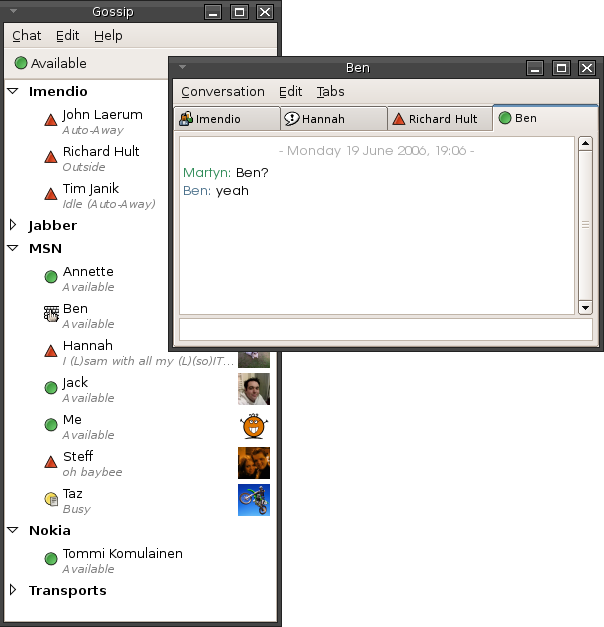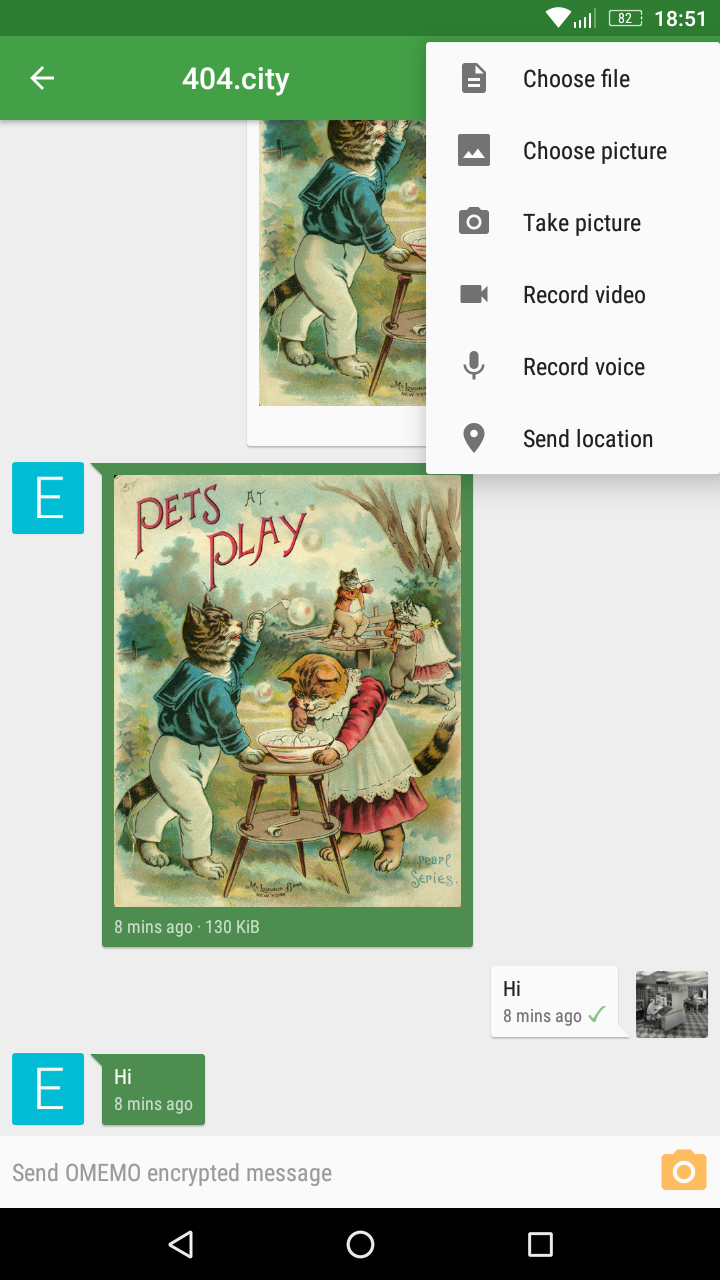|
XMPP Standards Foundation
XMPP Standards Foundation (XSF) is the foundation in charge of the standardization of the protocol extensions of XMPP, the open standard of instant messaging and presence of the IETF. History The XSF was originally called the Jabber Software Foundation (JSF). The Jabber Software Foundation was originally established to provide an independent, non-profit, legal entity to support the development community around Jabber technologies (and later XMPP). Originally its main focus was on developing JOSL, the Jabber Open Source License (since deprecated), and an open standards process for documenting the protocols used in the Jabber/XMPP developer community. Its founders included Michael Bauer and Peter Saint-Andre. Process Members of the XSF vote on acceptance of new members, a technical Council, and a Board of Directors. However, membership is not required to publish, view, or comment on the standards that it promulgates. The unit of work at the XSF is the XMPP Extension Protoco ... [...More Info...] [...Related Items...] OR: [Wikipedia] [Google] [Baidu] |
XMPP Logo
Extensible Messaging and Presence Protocol (XMPP, originally named Jabber) is an open communication protocol designed for instant messaging (IM), presence information, and contact list maintenance. Based on XML (Extensible Markup Language), it enables the near-real-time exchange of structured data between two or more network entities. Designed to be extensible, the protocol offers a multitude of applications beyond traditional IM in the broader realm of message-oriented middleware, including signalling for VoIP, video, file transfer, gaming and other uses. Unlike most commercial instant messaging protocols, XMPP is defined in an open standard in the application layer. The architecture of the XMPP network is similar to email; anyone can run their own XMPP server and there is no central master server. This federated open system approach allows users to interoperate with others on any server using a 'JID' user account, similar to an email address. XMPP implementations can be deve ... [...More Info...] [...Related Items...] OR: [Wikipedia] [Google] [Baidu] |
Extensible Messaging And Presence Protocol
Extensible Messaging and Presence Protocol (XMPP, originally named Jabber) is an Open standard, open communication protocol designed for instant messaging (IM), presence information, and contact list maintenance. Based on XML (Extensible Markup Language), it enables the near-real-time exchange of structured data between two or more network entities. Designed to be Extensibility, extensible, the protocol offers a multitude of applications beyond traditional IM in the broader realm of message-oriented middleware, including signalling for Voice over IP, VoIP, video, file transfer, Game, gaming and other uses. Unlike most commercial instant messaging protocols, XMPP is defined in an open standard in the application layer. The architecture of the XMPP network is similar to email; anyone can run their own XMPP server and there is no central master server. This Federation (information technology), federated open system (computing), open system approach allows users to interoperate with ... [...More Info...] [...Related Items...] OR: [Wikipedia] [Google] [Baidu] |
Instant Messaging
Instant messaging (IM) technology is a type of online chat allowing real-time text transmission over the Internet or another computer network. Messages are typically transmitted between two or more parties, when each user inputs text and triggers a transmission to the recipient(s), who are all connected on a common network. It differs from email in that conversations over instant messaging happen in real-time (hence "instant"). Most modern IM application (computing), applications (sometimes called "social messengers", "messaging apps" or "chat apps") use push technology and also add other features such as emojis (or graphical smileys), file transfer, chatbots, voice over IP, or Videotelephony, video chat capabilities. Instant messaging systems tend to facilitate connections between specified known users (often using a contact list also known as a "buddy list" or "friend list"), and can be standalone applications or integrated into e.g. a wider social media platform, or a website ... [...More Info...] [...Related Items...] OR: [Wikipedia] [Google] [Baidu] |
Internet Engineering Task Force
The Internet Engineering Task Force (IETF) is a standards organization for the Internet and is responsible for the technical standards that make up the Internet protocol suite (TCP/IP). It has no formal membership roster or requirements and all its participants are volunteers. Their work is usually funded by employers or other sponsors. The IETF was initially supported by the federal government of the United States but since 1993 has operated under the auspices of the Internet Society, an international non-profit organization. Organization The IETF is organized into a large number of working groups and birds of a feather informal discussion groups, each dealing with a specific topic. The IETF operates in a bottom-up task creation mode, largely driven by these working groups. Each working group has an appointed chairperson (or sometimes several co-chairs); a charter that describes its focus; and what it is expected to produce, and when. It is open to all who want to particip ... [...More Info...] [...Related Items...] OR: [Wikipedia] [Google] [Baidu] |
Jabber Open Source License
XMPP Standards Foundation (XSF) is the foundation in charge of the standardization of the protocol extensions of XMPP, the open standard of instant messaging and presence of the IETF. History The XSF was originally called the Jabber Software Foundation (JSF). The Jabber Software Foundation was originally established to provide an independent, non-profit, legal entity to support the development community around Jabber technologies (and later XMPP). Originally its main focus was on developing JOSL, the Jabber Open Source License (since deprecated), and an open standards process for documenting the protocols used in the Jabber/XMPP developer community. Its founders included Michael Bauer and Peter Saint-Andre. Process Members of the XSF vote on acceptance of new members, a technical Council, and a Board of Directors. However, membership is not required to publish, view, or comment on the standards that it promulgates. The unit of work at the XSF is the XMPP Extension Protoco ... [...More Info...] [...Related Items...] OR: [Wikipedia] [Google] [Baidu] |
Jeremie Miller
Jeremie Miller (born ) is the inventor of Jabber/XMPP technologies and was the primary developer of jabberd 1.0, the first XMPP server. He also wrote one of the first XML parsers in JavaScript. He began working on Jabber in 1998. Biography Miller is from Cascade, Iowa, and lives in Denver, Colorado. Miller began developing the software on his farm in Iowa. He attended Iowa State University where he studied computer and electrical design. He broke off his studies early in 1995 to join an Internet startup company. In May 2007, he was hired at Wikia to be technical lead for a project to create an open search engine called Wikia Search. Miller co-founded a company called Singly in 2010, which announced the Locker Project in 2011 and TeleHash projects. Singly was acquired by Appcelerator in August 2013 on undisclosed terms. References External links * , Robert McMillan, ''Linux Magazine ''Linux Magazine'' is an international magazine for Linux software enthusiasts an ... [...More Info...] [...Related Items...] OR: [Wikipedia] [Google] [Baidu] |
BOSH (protocol)
Bidirectional-streams Over Synchronous HTTP (BOSH) is a transport protocol that emulates a bidirectional stream between two entities (such as a client and a server) by using multiple synchronous HTTP request/response pairs without requiring the use of polling or asynchronous chunking. For applications that require both "push" and "pull" communications, BOSH is significantly more bandwidth-efficient and responsive than most other bidirectional HTTP-based transport protocols and AJAX. BOSH achieves this by avoiding HTTP polling, yet it does so without resorting to chunked HTTP responses as is done in the technique known as Comet. To date, BOSH has been used mainly as a transport for traffic exchanged between Jabber/XMPP clients and servers (e.g., to facilitate connections from web clients and from mobile clients on intermittent networks). For "push", a BOSH client starts an HTTP request, but the server postpones sending a reply until it has data to send. After receiving a reply, ... [...More Info...] [...Related Items...] OR: [Wikipedia] [Google] [Baidu] |
Jingle (protocol)
Jingle is an extension to XMPP (Extensible Messaging and Presence Protocol) which adds peer-to-peer (P2P) session control (signaling) for multimedia interactions such as in Voice over IP (VoIP) or videoconferencing communications. It was designed by Google and the XMPP Standards Foundation. The multimedia streams are delivered using the Real-time Transport Protocol (RTP). If needed, NAT traversal is assisted using Interactive Connectivity Establishment (ICE). , the proposed Jingle specification had not yet been approved by the XMPP Standards Foundation, but is now a Draft Standard, meaning: "''Implementations are encouraged and the protocol is appropriate for deployment in production systems, but some changes to the protocol are possible before it becomes a Final Standard.''" The libjingle library, used by Google Talk to implement Jingle, has been released to the public under a BSD license. It implements both the current standard protocol and the older, pre-standard version. ... [...More Info...] [...Related Items...] OR: [Wikipedia] [Google] [Baidu] |
XMPP Summit
Extensible Messaging and Presence Protocol (XMPP, originally named Jabber) is an open communication protocol designed for instant messaging (IM), presence information, and contact list maintenance. Based on XML (Extensible Markup Language), it enables the near-real-time exchange of structured data between two or more network entities. Designed to be extensible, the protocol offers a multitude of applications beyond traditional IM in the broader realm of message-oriented middleware, including signalling for VoIP, video, file transfer, gaming and other uses. Unlike most commercial instant messaging protocols, XMPP is defined in an open standard in the application layer. The architecture of the XMPP network is similar to email; anyone can run their own XMPP server and there is no central master server. This federated open system approach allows users to interoperate with others on any server using a 'JID' user account, similar to an email address. XMPP implementations can be devel ... [...More Info...] [...Related Items...] OR: [Wikipedia] [Google] [Baidu] |
FOSDEM
Free and Open source Software Developers' European Meeting (FOSDEM) is a non-commercial, volunteer-organized European event centered on free and open-source software development. It is aimed at developers and anyone interested in the free and open-source software movement. It aims to enable developers to meet and to promote the awareness and use of free and open-source software. FOSDEM is held annually, usually during the first weekend of February, at the Université Libre de Bruxelles Solbosch campus in the southeast of Brussels, Belgium. History FOSDEM was started in 2000 under the name Open Source Developers of Europe Meeting (OSDEM) by Raphael Bauduin. Bauduin said that since he felt he lacked the brains to properly contribute to the open-source community, he wanted to contribute by launching a European event in Brussels. Bauduin teamed up with Damien Sandras. The team repeated the event. The F (of FOSDEM) was added at the request of Richard Stallman. The event has ... [...More Info...] [...Related Items...] OR: [Wikipedia] [Google] [Baidu] |
Instant Messaging
Instant messaging (IM) technology is a type of online chat allowing real-time text transmission over the Internet or another computer network. Messages are typically transmitted between two or more parties, when each user inputs text and triggers a transmission to the recipient(s), who are all connected on a common network. It differs from email in that conversations over instant messaging happen in real-time (hence "instant"). Most modern IM application (computing), applications (sometimes called "social messengers", "messaging apps" or "chat apps") use push technology and also add other features such as emojis (or graphical smileys), file transfer, chatbots, voice over IP, or Videotelephony, video chat capabilities. Instant messaging systems tend to facilitate connections between specified known users (often using a contact list also known as a "buddy list" or "friend list"), and can be standalone applications or integrated into e.g. a wider social media platform, or a website ... [...More Info...] [...Related Items...] OR: [Wikipedia] [Google] [Baidu] |



